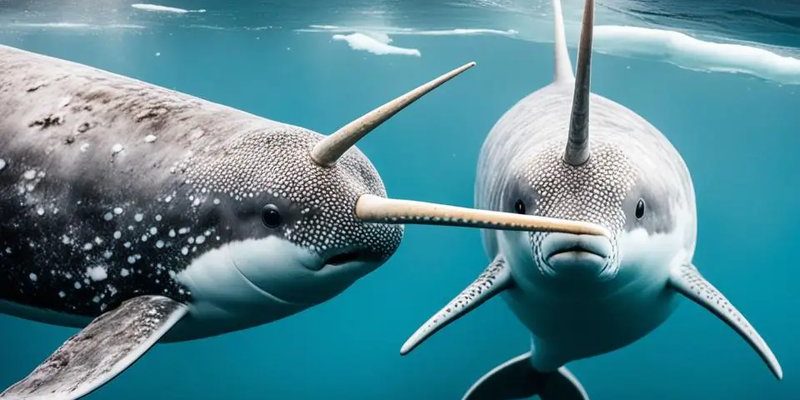
So, what does the breeding process of a narwhal look like? Honestly, it’s not just about finding a mate. It involves a unique array of behaviors, environmental factors, and biological processes that ensure the survival of their species. In this article, we’ll dive deep into the mysteries of narwhal reproduction, exploring their mating rituals, gestation periods, and the challenges they face, all while keeping it straightforward and friendly—like a chat over coffee.
Narwhal Mating Behavior
When it comes to mating, narwhals have some distinct behaviors that set them apart from other marine mammals. During the breeding season, which typically runs from late winter to early summer, narwhals undertake some impressive displays. These can include vocalizations, physical displays, and even the famous tusk jousting between males. It might look like a sword fight underwater, but this ritual helps establish dominance and attract potential mates.
Males often engage in social behaviors that can seem playful or aggressive. Think of it as a sort of underwater dance-off, where the goal is to impress females. The stronger and more skilled the male, the better his chances of mating. Females are quite discerning, and they’re looking for the healthiest and most dominant males to ensure the best genetic traits for their offspring.
Breeding Season Timeline
The breeding season for narwhals is tightly linked to environmental factors. As the ice begins to melt in the Arctic waters, narwhals start to gather in groups known as pods. These pods typically consist of both males and females, and they play a crucial role in the breeding process.
Once mating occurs, it’s not a quick process. Narwhals have a long gestation period—about 14 to 16 months! Imagine waiting patiently for a year and a half for your little one to arrive. This extended period allows the fetus to develop fully in the protective environment of its mother. During this time, the mother will need plenty of nourishment, which comes from hunting in the icy waters.
Gestation and Calving
Once the gestation period is over, it’s time for the mother narwhal to give birth. Typically, narwhals give birth to a single calf, although twins can occur in rare cases. Calving usually takes place in the summer months when the waters are less icy, making it easier for the young calf to adapt to its environment.
When the calf is born, it’s already about 4 to 5 feet long! That’s a pretty impressive size for a newborn. The mother immediately begins to care for her calf, nursing it with rich milk that helps it grow quickly. This nurturing bond is crucial, as the calf relies on its mother for survival in those early days.
Parental Care and Social Structure
Parental care in narwhals is primarily the responsibility of the mother. After giving birth, she will stay close to her calf for several months, guiding it in learning essential survival skills. You might be wondering how this works under the ice. Narwhal calves can swim almost immediately after birth, but they need to practice foraging and navigating through their icy habitat.
The social structure of narwhals is fascinating too. They often live in pods, which provide safety in numbers and a supportive environment for mothers and calves. These groups can help protect young narwhals from potential threats, such as predators. As the calf grows, it begins to interact more with the pod, learning from other members, which is vital for its development.
Challenges to Narwhal Reproduction
Unfortunately, narwhals face numerous challenges that can affect their breeding and reproductive success. Climate change is a significant concern. As temperatures rise, the ice melts, altering their habitat and hunting grounds. This makes it harder for them to find food and raises the stakes for pregnant females, who need to sustain themselves and their calves.
Human activities, such as shipping and oil exploration, can also disrupt narwhal breeding grounds. Noise pollution from boats can interfere with their communication, which is vital during mating season. Additionally, increased ship traffic can lead to accidental collisions. All these factors combine to create a challenging environment for narwhals, making conservation efforts crucial.
Conservation Efforts for Narwhals
Given the unique challenges faced by narwhals, various conservation efforts are underway to protect these magnificent creatures. Organizations and researchers are working hard to monitor narwhal populations and their habitats. This includes studying their behavior, breeding patterns, and how they respond to environmental changes.
You might be wondering what can be done from an individual standpoint. Supporting wildlife conservation organizations, reducing carbon footprints, and advocating for policies that protect Arctic ecosystems can all contribute to the ongoing effort to save narwhals. Every little bit helps!
The Role of Research in Narwhal Reproduction
Research plays a vital role in understanding narwhal reproduction. Scientists study their mating habits, gestation periods, and challenges in detail. By gathering data, researchers can develop targeted conservation strategies to ensure healthy narwhal populations for the future.
For example, satellite tags are often used to track narwhals’ movements and habitats. This information sheds light on their breeding patterns and helps create protected areas where they can thrive. It’s like giving them a safe haven in a changing world—a crucial step in ensuring their survival.
In conclusion, the breeding and reproduction of the narwhal is a complex yet fascinating process that showcases nature’s ingenuity. From their unique mating rituals to the mother-calf bond that develops, narwhals are a testament to the wonders of the animal kingdom. Understanding their life cycle not only enriches our knowledge of these incredible creatures but also underscores the importance of protecting their Arctic habitat for generations to come. Every aspect of their reproduction—from mating to calving, caring, and overcoming environmental challenges—tells a story worth sharing and protecting.

